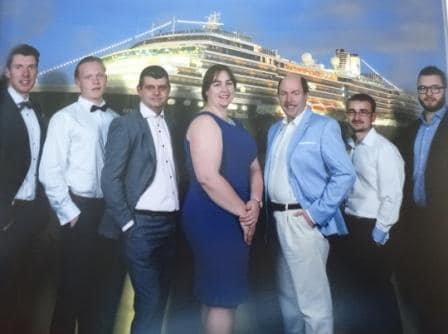To get to our first port of call on the straightest route possible we have two obstacles in the way, called the islands of Corsica (Corse) and Sardinia. But as they are islands there is water in between and that water is wide enough to sail through. It is called Boniface Strait or the Strait of Bonifacio. The old romans called it Fretum Gallicum and this translates in something like the Wild Waters of the Gaul’s. In the word Fretum we can recognize our English word of fretting or worrying about something. And that is a good word for this area as it can be a very nasty place. Strait Bonifacio which connects the Tyrrhenian Sea from the Western Mediterranean Sea can throw anything at a sailor that he/she does not like. It can blow a (local) gale here, it is full of shallows and nasty rocks, the currents are un-predictable and there is an almost 90o turn to make when going through the Strait. Therefore there is a pilot service available for those ships who do not have the most sophisticated navigation equipment on board and for oil tankers it is compulsory to take a pilot. Continue reading
Category: Trans-Atlantic (page 2 of 3)
Although the Europe season is drawing to an end, that is the high season, as some cruise ships will cruise the Mediterranean all year around, it was still busy in port today. Azamara Journey, Nautica, Brilliance of the Seas and us made sure that all the cruise docks were full. Only the “over spill” dock, the container terminal on the other side of the port was not used and thus a container ship was alongside. We were the only ship who had a change over today and thus we were parked at the big cruise terminal. This one has two jet walks as at the airport so guests can go ashore without being touched by the elements. Those elements were quite benign today and the chance of showers forecasted did not materialize. At least not over the port. If there are more cruise ships in port with a change over, then the port authority uses the pecking order system and the largest ship gets the best terminal. There are two more terminals, which are much smaller and are basically semi-permanent marquis structures. For the container terminal which has nothing, they bring in a large marquis which can accommodate 500 to 600 people. Nowadays a necessity as all those boarding people have to shuffle through security screening and that is not very nice if it rains. And coming off the ships, the suitcases should preferably stay dry as well. Continue reading
Last night we sailed by the volcano Stromboli which was as expected – sort of active- and with that cryptic description I mean it was spewing hot lava at an almost constant pace but in small spurts so there was no big drama and or explosions. Still very nice to look at, as it was very well visible in the dark night. Stromboli has been constantly active for a large number of years but since the 1950’s it has not had a major eruption or explosion. The cone is also not in the center but located on the north east side and that makes it possible that there are approx. 300 people living on the south & west slope of the volcano.
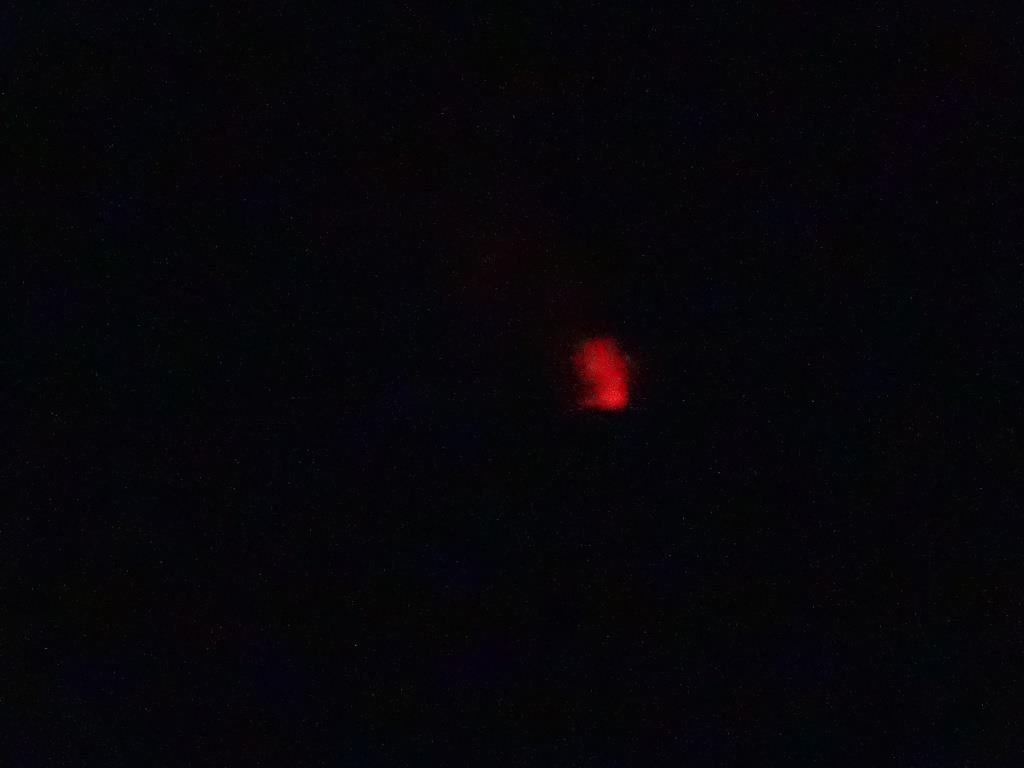
I do not carry a turbo camera with 40 mega pixel etc. So this was the best I could do. But the oh’s and the ah’s from the balconies did indicate that is was appreciated by the guests and the view a lot better than my little camera can picture.
They had a major eruption in 1953 and then about 1700 inhabitants left but nowadays the island is slowly being repopulated. In the summer time it has a lot of tourists who come for a visit as it is quite safe to climb the volcano as long as you know where to go. I was wondering why cruise ships do not stop off here, but due to the exposed landing site for the tenders it would be nearly impossible to plan it into a cruise schedule as 9 out of 10 times the swell might be too high to bring boats alongside. So the tourists come with a ferry boat and that is much easier as those sailings are simply weather dependent anyway.
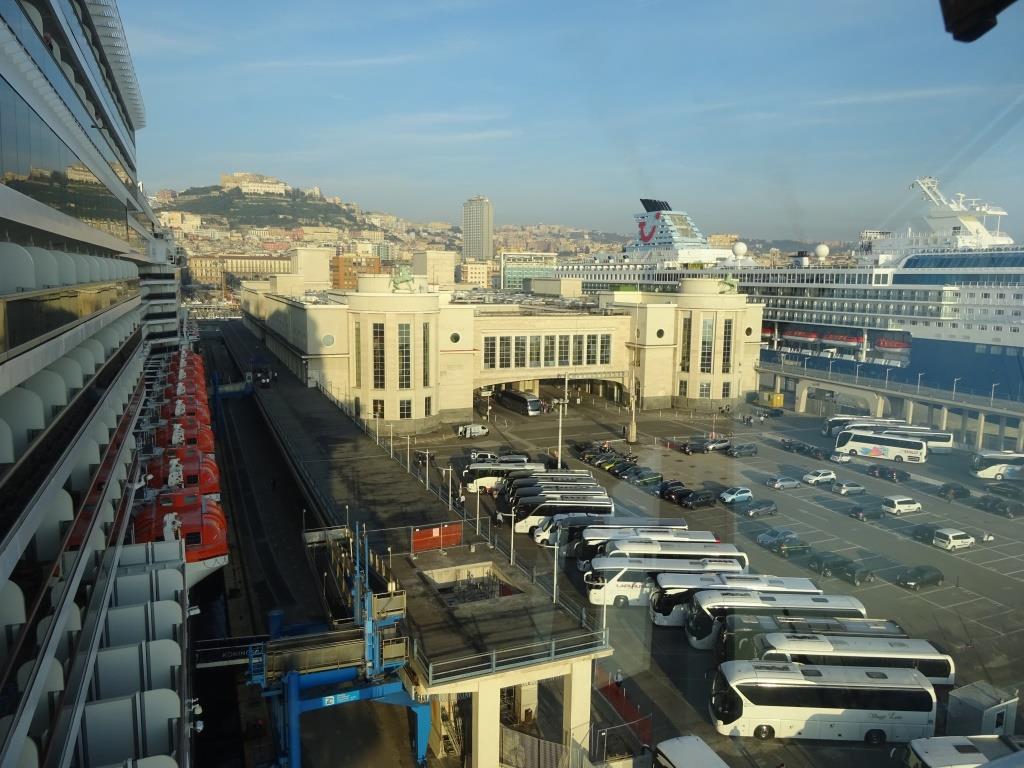
The passenger terminal as seen from the bridge. Opened in 1935 and since then very little has changed (For more details: https://thebeautyoftransport.com/2018/01/10/neapolitan-delight-naples-marine-terminal/)
This morning by 06.30 we were safely parked at the west side of the Cruise Terminal of Naples which is really the Passenger Liner Terminal from the old days. (The main difference is that the old waiting rooms have been converted into shops and some conference and/or exhibition areas) The building is a left over from the Mussolini period. He might have done a lot of bad things but he did restructure the Italian transport systems. The trains ran on time from that moment on (and they still do to a large extent) and all the squabbling ocean liner companies were brought together into the Italia Line, or when staying out of it, aligned in such a way that there was a good structure to the whole sea going transport system. It also resulted in the only time that that an Italian company won the Blue Riband for the fastest Trans-Atlantic crossing to New York. As the terminal was built in the heyday of Italian nationalism (called Fascism here) the terminal is a concrete nihilistic structure with a little bit of Art Deco elements in it but with rampant horses on the sea side face of the building to give it a macho touch. It has been adapted with fly overs and walk ways in the later years to make it easier for the cruise ships to get their gangways out on an even level.
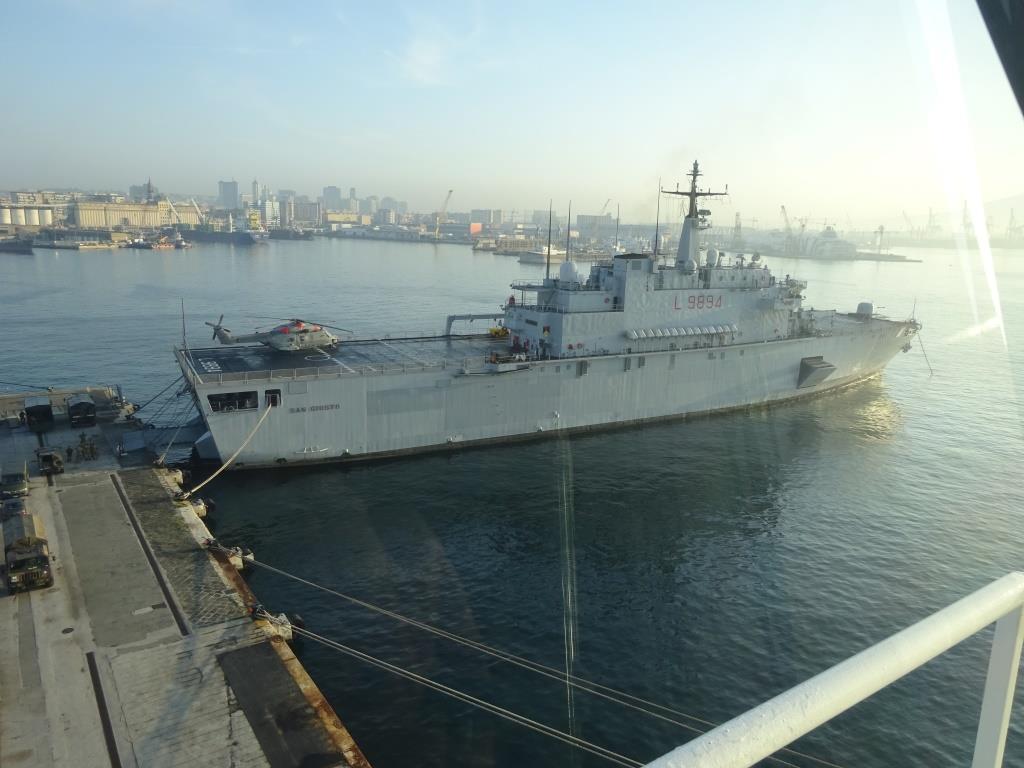
The San Guisto. Docked in style Mediterranee. The bow is kept in place by the anchor and the stern ramps provides access.
Docked right below the rampant horses was an Italian amphibious transport dock ship of the Italian Navy called the St.Guisto (pennant number L9894). Dock ship means that it has ramps and a dry marina in the stern so it can have on board a number of landing and patrol craft. The sort of thing that you need if you start an invasion somewhere. It has always puzzled me that a war ship would carry the name of a saint, as saints are supposed “saintly” and not involved in warfare. But it is all traditional and the St.Guisto name is not used for the first time in the Italian navy but goes long ways back.
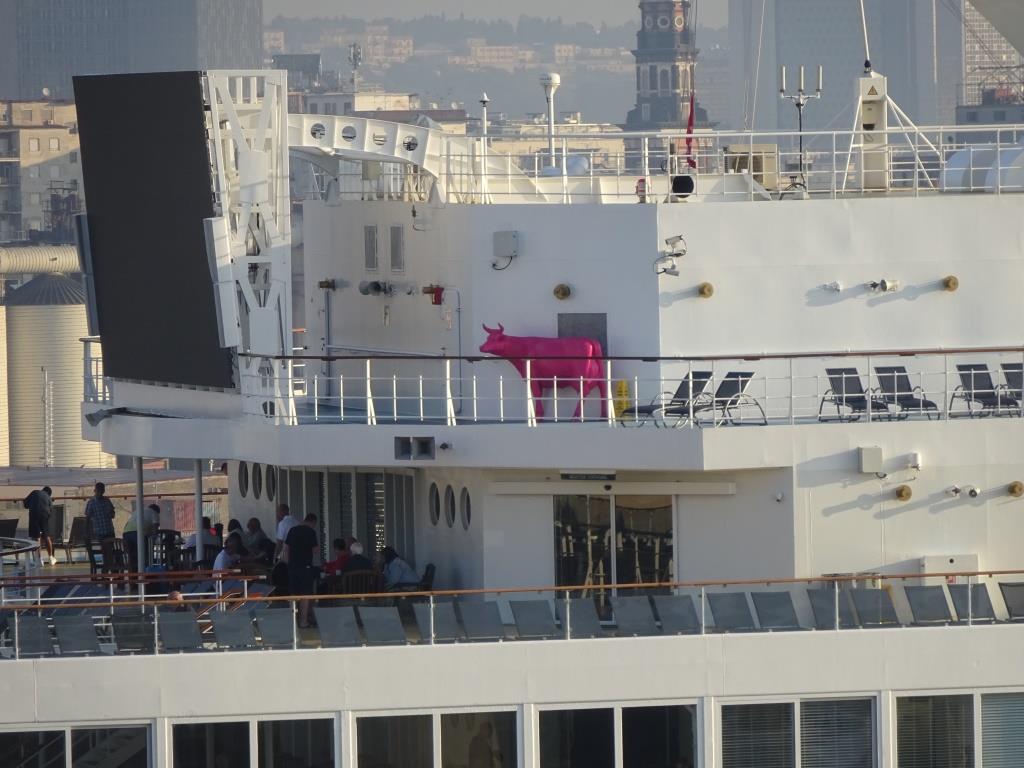
While looking at the Marella Explorer 2, I saw this pink/purple cow on the top deck. I have no idea what it was doing there but…………. the Koningsdam can do better. See below.
We were not the only cruise ship in port as next to us was the Marella Explorer II, which had sailed from Malta as well, as it was leaving dry dock the day the Koningsdam left. So they were in port today to start there cruises again after having had their refit. Marella is a sub company of TUI which is a (German) sub company of RCI. Tui in this way operates modern ships by means of the “Mein Schiff” series and then an older ships operation which is called Marella. Marella also employ our old Noordam (III) and Westerdam (II). If I was to explain how this whole operation works with all these sub companies then I could fill about 5 blogs but that information is readily available on Wikipedia.
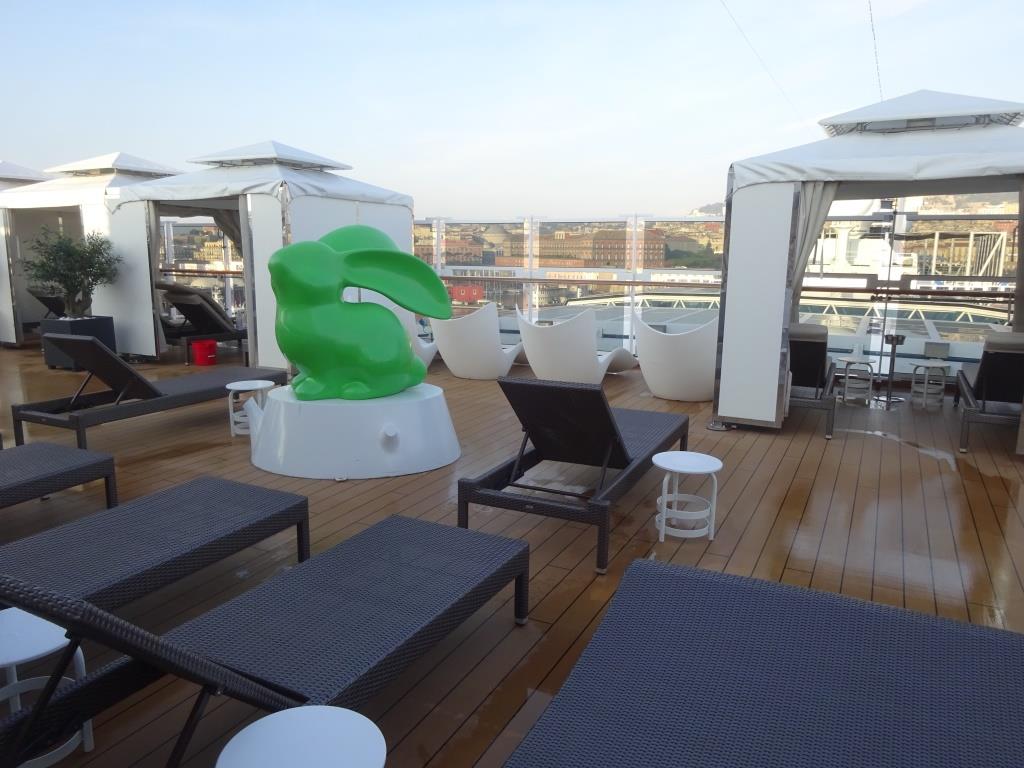
Because we have a bunny. This statue is located on Deck 14 where the Cabanas are located and forms the focus point of the whole area.
The weather forecast for today, as on arrival, was a chance of showers although it never materialized. But as a result we could not see Vesuvius from the ship as its cone was covered in clouds. Maybe not a bad thing because if it would explode, then there would be instant rain available to douse the flames again. The nice result was however that a large number of guests took their cabin umbrella with them and orange was seen all over the port. The other ships still have blue umbrellas but with the arrival of the Pinnacle Class the umbrellas changed to orange, as now everything that is part of the in-house-design has a touch of orange to it. Starting with the uniforms and ending with the shoe laces of my safety shoes. (orange/black braid)
My day was spent on trainings. These are regular trainings that are normally conducted by the 2nd officer training on board but I have started to realize that in some instances it helps that the crew gets a little push from somebody with authority to realize that they are really are allowed what they are trained for. Especially if it is something that is outside their comfort zone of their job level. It is a big step for a new assistant cook, fresh out of the Philippines, to push the big red button which shuts down the whole galley ventilation, but if it has to be done, it has to be done. And in this way I can provide the backup which can let them say: I did it for safety and Captain Albert told me I could do so.
Tomorrow we are in Civvitavecchia, the gateway to Rome; and for a lot of guests the gateway to the airport of Leonardo da Vinci in Fiumicino/Rome as tomorrow is change over day. Then tomorrow afternoon we start our Trans-Atlantic cruise which will take us to Fort Lauderdale where we are scheduled to arrive on November 13th.
Weather for tomorrow: Overcast with an increasing chance of rain after 10 am. 21oC / 71oF.
We had a bit of a bumpy night and a slightly moving ship. What “slightly” was depended on the view of the guests as some spoke of a heavy storm and some dismissed it as an occasional “bump”. I have been assigned a cabin above the Azipods this time and the only thing I had to do was to move the coat hangers in the closet as they rattled on occasion. That is not a regular ships noise and thus it will wake me up. We did have quite a bit of wind during the night with gusts to over 60 knots but as we were heading into the first arrival of the storm, the storm had not been able to generate very high waves and thus the ship did not provide the roller coaster ride, something some guests had been afraid of. Continue reading
By 10 am this morning we were at anchor at Newport. Further out than we really liked as the Riviera had the best spot because she had arrived earlier. It was sunny but there was a strong breeze blowing, stronger than we had hoped for as the wind was only supposed to get really going in the early evening. Referring to my blog of yesterday: the weather was not really organized. Still the circumstances were good enough to operate a tender service and thus the ship got things on the road. We had even drafted in a local tender, the Amazing Grace and later another on, the Katharine, to cover the long tender distance as good as possible. Still it was slow going for a while, due to the tender distance but also due to the wind which forced the tenders to be extra careful. But still it worked. Continue reading
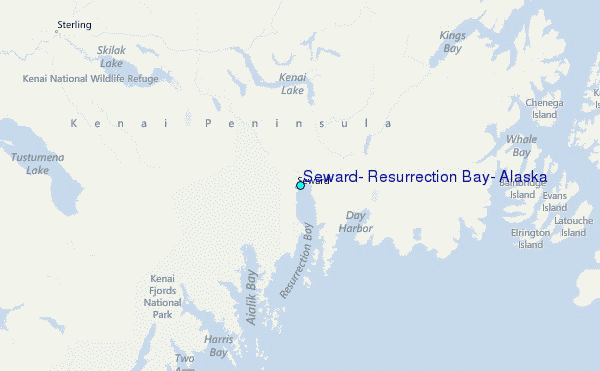
Seward is located at the end of Resurrection Bay and used to be the Ferry connection to the interior.
We had a glorious day today while the temperatures remained under the mid-sixties (18o Celsius) Just low enough not to cause restricted visibility and just low enough not to get hot and bothered while pulling suitcases. But high enough to enjoy a gentle summer morning while travelling. This is a very early morning arrival for everybody and certainly for the ship’s crew. The guests coming from the overland tours mostly arrive in Anchorage the night before, so do those who fly in for the cruise only experience do the same. They all converge on Anchorage, which is a 2.5 hours’ drive from Seward. How to get 2000 people down there and the same number back is logistical tour de force. And thus you have to start early.
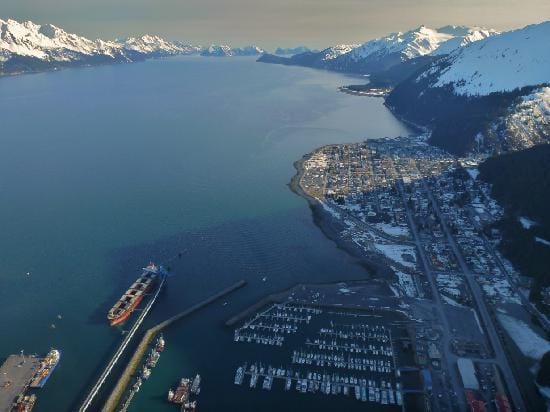
The dock is to the left of the cargo ship which is docked at the Coal terminal. We do not like a ship at that location when we are in, as it makes it difficult for us to get in. But the Marina is nice for tender training. Wintery stock photo from somewhere on the internet.
The ship has to be docked by 05.30 and the first wave of disembarkation starts at 06.00 hrs. This means that the Bridge and Engine room go to battle stations around 03.30, when the ship approaches Resurrection Bay (*). The pilot comes on board at the entrance at 04.30 and then the ship will just be docked at 05.30 hrs. with the gangway out. Contrary to other disembarkation ports, most guests do not have to take their luggage with them on the coach. They either find it back at the airport or at their first hotel stop while going overland. So when the first wave leave at 06.00 hrs. to take the train to Anchorage, the luggage is still being offloaded and is following in a truck. The system seems to work very well as I seldom hear about problems with a suitcase ending up somewhere else than where it was supposed to go.
(*) And I do not even mention the hotel department, as breakfast starts at 05.30. which means some of the cooks are already running around at 03.30 in the morning as well. If to boil an egg takes a lot of planning let alone to set up the complete lido buffet and be ready for 300+ guests who all show up at the same time.
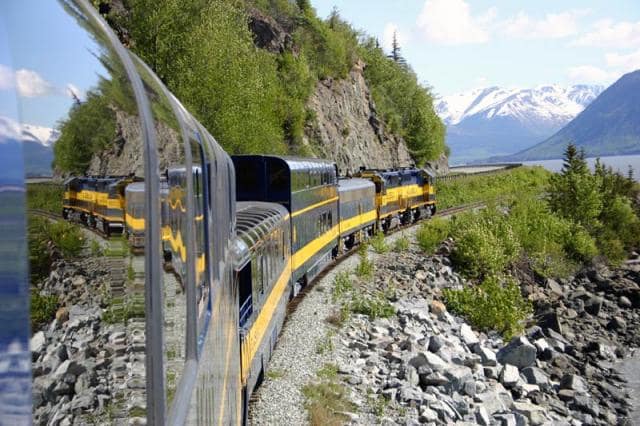
We use the local train service from Seward, but they do have Panoramic Cars, before the guests move to our own trains to Denali.
Then for the remainder of the morning, groups are being called out, they call them “waves” here in Seward, as soon as the busses are available. These busses or coaches take some groups to Anchorage where they change to our inland trains or to other buses which go up into the interior. These shuttle buses then bring back the new guests to the ship. The result is a very staggered and non-rushed operation with the last guests arriving around 18.00 hrs. at the ship and the last luggage being on board by 19.00 hrs. The follows boat drill and then we are on our way south again. While a whole port call in Ft. Lauderdale takes (pilot to pilot) from 05.30 to 18.30, here the whole evolution lasts from 04.30 to 21.00 hrs. Although the pace is less hectic.
Today we also had the end of the Ramadan for our Muslim community and that is normally celebrated with an Idul-Fitri meal. Because of change over day we had to postpone that until tomorrow as such a celebration should not be rushed and the special food for the feast meal needs more time to prepare. In the same way as we sometimes move Christmas dinner for the crew as well, if it is too close to embarkation day.
I took my school class down in the tender today, for their first practical lessons of tender driving and a lot of the conversation was about if the Cook would get the fried rice (Nasi Goreng) exactly right. That seems to have been an issue in the past. I always like it when they are nattering away in their local language as you pick up interesting tid-bits of information and sometimes they are quite shocked that I understand much more than they think. 37 years of being involved with Indonesians gives you a good insight in the language even when they speak a sort of sailor slang.
Teaching a novice how to drive a tender and make him understand what is better is not so easy, as most of the trainee’s think that speed solves all problems. Either full ahead or full astern. This is not the case as it only makes the tender harder to control so I try to explain that driving a tender is like dancing with a very big and tall lady. You cannot get your arms around her, she is much taller than you are, and if you push her, you cannot stop the momentum. So you have to nudge her gently to sway with her over the dance floor in the right direction. So we spent a whole morning dancing around the ship and in and out of the Marina.
Tomorrow we are at sea again, retracing our steps to Glacier Bay. The Gulf of Alaska is to remain quiet for the coming days with only a low swell running from the South West. It should be a nice ride with a gentle breeze pushing in the back.
Over the past weekend the Holland America Blog was successfully revamped and transferred to a new server. Apologies for the delay of what was supposed to be only a few days of disruption. But if a P.C can sometimes have challenges on a small scale, a web setup can have bigger ones on a more industrial scale I suppose.
I stopped blogging at the end of my Zuiderdam period and because of the transfer I could not do anything during my period on the Westerdam. Most of that period consisted of a crossing from Ft. Lauderdale to Europe and then a number of Mediterranean ports before the cruise ended in Civittavecchia. I then went home and the Westerdam went into dry dock for a regular check up but also for a major revamp of the public rooms and the addition of some guest cabins on deck 10. As a result the ship is now similar to the Oosterdam which was the one but last of the Vista Class to go through the upgrade dry dock. The Westerdam is now the last one of the Vista Class that received the regular upgrades but also the best of the Koningsdam upgrades that were also rolled out earlier on the Oosterdam and Eurodam. This includes the Gallery Bar (ex Northern Lights Disco), the Billboard on Board (located on the starboard side by taking part of the Casino away) and a new feature, a small museum with Dutch Art sponsored by the Rijksmuseum from Amsterdam. It is located opposite the Front Office on Main deck where once the Shorex office was. The shore excursion office has been moved to the Crows nest as part of the companies re-focussing on the combination of enjoyable cruising and cultural immersion at the same time.
My activities on the crossing consisted of training a new group of Navigators who had joined Holland America in the previous weeks. 5 gentlemen (Dutch & Rumanian) and one Lady from Canada. The latter had sailed on the Canadian Coastal vessels and made about 20 cruises with her family on Holland America Line ships. Now she learned the other side of cruising and soon found out that there is a lot of hard work going on behind the glamour. By the time they made it to Civitavecchia , they were all well aware of what it takes to be a Holland America Line Officer and can now walk onto their first ship with enough confidence to fit right into the bridge teams.
Thus I went home on April 13 as the presence of an extra captain during a dry dock only confuses the issue. I am now enjoying a month of vacation and then it is time for the ships sailing from Canada. I will update my schedule-tab as well but this is the plan for the near future………….. as usual subject to very much change.
18 May – 03 June ms Maasdam, Canadian Maritimes. Boston to Montreal and back.
03 June – 25 June ms Noordam, Vancouver – Seward – Vancouver.
27 June – 23 July ms Zaandam, Vancouver – Seward – Vancouver.
After that I will have another break in the schedule.
In the mean time I am keeping myself constructively occupied by supervising our phase 3 roof maintenance of the apartment building which I live in.
I will be back with the blog on the 18th of May.
 Captain Albert Schoonderbeek
Captain Albert Schoonderbeek
This was the last full day of our crossing and un-expectedly we came under the influence of some bad weather all the way to the North. A rather heavy system with lots of wind is moving towards the United Kingdom and that pushed a minor system, near the Gulf of Biscay, a bit further down. As a result the wave field generated by that minor system made it all the way down to our area and thus we had a Prinsendam that moved a little bit more than in the past few days. Still for an ocean crossing, not much movement at all. Later in the day the sun even came out and that was not predicted either.
I have been writing about waves and wave fields during this crossing. So the question should be answered what is a wave is and how do we measure it. On the bridge, for our observations, we eye ball it. A junior navigator has a sample book available with photos that indicate wave heights and that can be used to compare with what is out there. With a little bit of help from a senior officer it is then fairly quickly becoming routine to observe correctly what the wave heights are. Satellites can do the same nowadays with infra red beams which are extremely accurate in measuring the exact height. So are experienced sailors and we do it by just looking out of the window. The height of a wave is measured from its lowest point, the trough, to it highest point, the crest.
Now waves are never the same height. The wind blowing over them changes the height, another wave pattern might interfere and cancel much of the achieved height out etc. etc. Thus for measuring the average wave height we use the significant wave height. That is also the wave height indicated on the chart I attached a few days ago. The definition of the Significant Wave Height: is the average height (trough to crest) of the one-third highest waves valid for the indicated 12 hour period. This means that you can come across waves of double the height, or a nearly smooth patch of sea, where two waves have cancelled each other out. However for the prediction of what the ship will encounter in the near future, the significant wave height on the wave chart suffices.
 Captain Albert Schoonderbeek
Captain Albert Schoonderbeek
This is our last day at sea before we arrive at Punta Delgada in the Azores. The weather is still holding, overcast as predicted and with a low to moderate swell (4 to 5 feet), which makes the Prinsendam gently pitch. It does not look like this weather will change very much in the coming period and that will mean that we have had a very good crossing, especially for the time of year, as summer has not arrived yet. As mentioned before, we have made up the time lost from our crew medivac in Bermuda and that means that we will arrive on time. I am even planning to be a little bit early so that we have time to clear the ship and set everything up before our official arrival time.
We had a bit of excitement today as we were first hailed by a French warship and then later on buzzed by a surveillance plane of unknown registry, although we think that it was a Portuguese one, as it came and went back directly in the direction of the Azores. We were not surprised that we were encountering navy in this area. The Europeans have stepped up their surveillance against ships polluting the oceans and at the same time are casting a forever watchful eye against drug trafficking. Although the latter is not so significant here, as we are in the middle of nowhere. Most drugs are transported over the oceans in regular containers.
However pollution is a major issue and navy ships work together with air planes to monitor traffic and to catch offenders. There are still ships out there who want to save some money by not off loading waste oil and think that they can dump it overboard without a problem. Although every waste stream onboard has to be recorded and thus also each amount of waste oil generated; cooking the books still happens and money is being saved by pumping engine waste directly over board. With an airplane these violations are easily spotted as a clearly visible trail can be seen from the air. From the surface it is much more difficult as the ships propellers disturb the ocean surface by their turning and that makes it very difficult to see for an observer if anything is being dumped. Thus the reason that there are surveillance planes around.
The French navy ship called us with a whole list of questions, I suppose to satisfy its own reporting needs and my watch officer was quite occupied with providing the correct answers. The moment supreme (most appropriate word I think when dealing with the French) came when the captain’s name had to be given. Thus was a hurdle for my English navigator, so I decided to answer myself and started spelling my full name. After the 22 letters there was a brief silence and then…………….Thank you have a nice voyage; end of questioning. Either my name did not fit in the check list that had to be filled out, or the operator was not in the mood to repeat it all or try to pronounce it. Anyway we continued happily on our way, leaving the French behind in the distance.
 Captain Albert Schoonderbeek
Captain Albert Schoonderbeek
We continued our crossing with good weather. Partly Cloudy skies with a little swell that kept the ship just pitching a little bit. The weather is supposed to remain good but a broad band of clouds is coming over the North Atlantic so it is expected that from this evening until Lisbon we will have cloudy skies. No rain is expected although we see on the radar occasional small rain showers in the vicinity. Rain does reflect on the radar. Especially a dense rain down pour acts as a reflector to a normal radar beam. We can boost the radar waves so that they penetrate rain clouds. However most of the time we keep the radars on a nice weather setting as that setting gives a better reflection of normal targets. However, with seeing the rain clouds on the radar comes the option (if they are not too large) to sail around the clouds and in that way keep the ship dry.
While the weather remains very good, there is more swell predicted on the last stretch of our crossing to Punta Delgada. To the north of us, roughly on the line Halifax, Greenland, Scotland, the weather is not so good. Weather fronts with considerable wind are crossing the North Atlantic and these winds generate waves. If that lasts for some time then the waves become swell and a wave field, that can travel a considerable distance away from the area from where they were generated. Generally a wave field will travel in the direction of the path of the weather front and that is mostly North East or East. Thus in our case, sailing further to the South we do not notice that much. However some waves/swell will travel in other directions, basically in the same way as when you throw a stone in the water and see the ripples going in all directions. If you throw the stone under an angle the ripples will be stronger to one direction than towards another but still some ripples will go another way. It is the same with wave and swell generated by wind, and of course the stronger the wind, the higher the waves are whipped up and the more we will notice it eventually.
I have included a wave chart this time; a chart that I check each morning on the internet. It is of course important to know for the guests if we get wobbly weather but also how high the waves will be. This to see if they will affect the ships speed. The ships movement called pitching (up and down movement of the bow) can result in a significant reduction in speed if it goes from just a gentle movement to a more severe form. By the time the bow is slamming into the waves you can loose up to 25% of your speed.
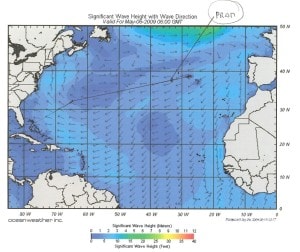
The lighter the color; the higher the waves. As you can see the Prinsendam has been travelling through fairly dark blue area’s so we have had very little to content with.
© 2025 – Captain Albert's Website and Blog –
Theme by Anders Noren — Up ↑
